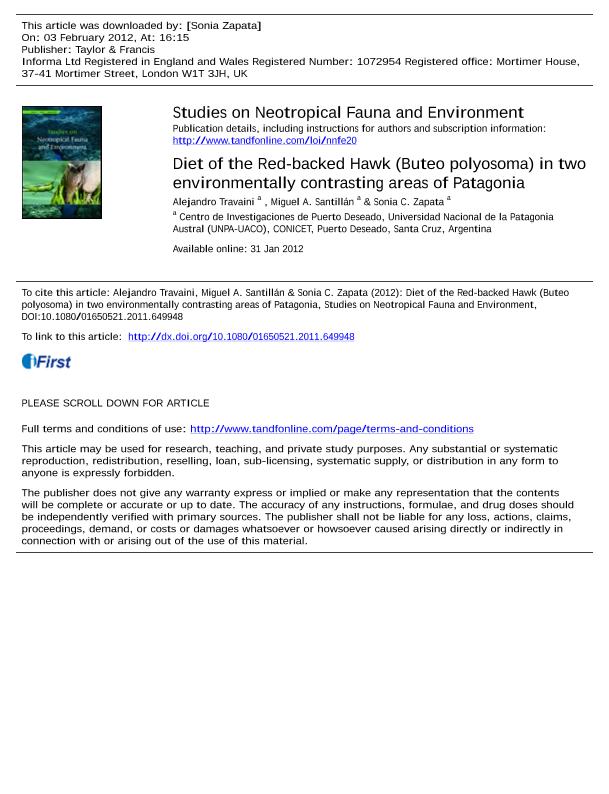Artículo
Diet of the Red-backed Hawk (Buteo polyosoma) in two environmentally contrasting areas of Patagonia
Fecha de publicación:
02/2012
Editorial:
Taylor & Francis Ltd
Revista:
Studies on Neotropical Fauna and Environment
ISSN:
0165-0521
Idioma:
Inglés
Tipo de recurso:
Artículo publicado
Clasificación temática:
Resumen
We studied the Red-backed Hawk (Buteo polyosoma) diet by pellet analysis in two areas, the Monumento Natural Bosques Petrificados (MNBP) and Junín de los Andes, located in southern and northwestern Argentinean Patagonia respectively. These areas have different values of primary production mainly due to the differences in mean annual precipitation, being higher in Junín de los Andes. Diets were dominated by mammals in both areas (68.3% and 61% of occurrences). Rodents represented the greatest proportion (66.5%) of prey numbers in MNBP. They represented 92.6% of the biomass. Arthropods were also consumed with a relatively high occurrence (21.4%). In Junín de los Andes, rodents were an important prey (57.1%) but represented only 29.6% of the consumed biomass. In contrast, the introduced European hare (Lepus europaeus) was not frequently consumed (13.5%) but comprised 59.3% of prey biomass. Reptiles were a frequent item, consumed at 25.2% of total prey. The diet of the Red-backed Hawk was significantly different between MNBP and Junín de los Andes. The wider food niche breadth of the Red-backed Hawk in Junín de los Andes was likely attributable to the more even distribution of prey categories. Additionally, a functional response toward European hare consumption was observed, with a higher consumption of this prey at Junín de los Andes.
Palabras clave:
ARGENTINEAN PATAGONIA
,
BUTEO POLYOSOMA
,
DIET
,
EUROPEAN HARE
,
FUNCTIONAL RESPONSE
Archivos asociados
Licencia
Identificadores
Colecciones
Articulos(SEDE CENTRAL)
Articulos de SEDE CENTRAL
Articulos de SEDE CENTRAL
Citación
Travaini, Alejandro; Santillán, Miguel Ángel; Zapata, Sonia Cristina; Diet of the Red-backed Hawk (Buteo polyosoma) in two environmentally contrasting areas of Patagonia; Taylor & Francis Ltd; Studies on Neotropical Fauna and Environment; 47; 1; 2-2012; 25-32
Compartir
Altmétricas




